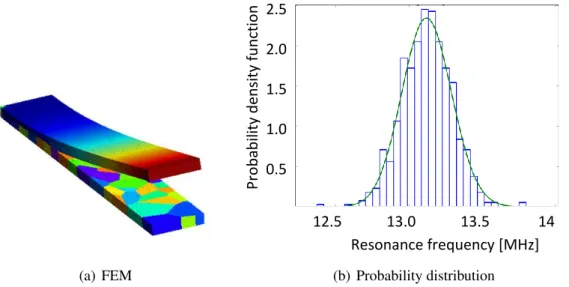A probabilistic multi-scale model for polycrystalline MEMS resonators
V. Lucas L. Wu†, S. Paquay‡, J.-C. Golinval†, L. Noels††
Department of Aerospace and Mechanical Engineering
University of Liege, Chemin des Chevreuils 1, B-4000 Liege, Belgium {vincent.lucas, l.wu, jc.golinval, l.noels}@ulg.ac.be
‡Open Engineering SA,
Rue des Chasseurs-Ardennais 3, B-4031, Li`ege (Angleur), Belgium. s.paquay@open-engineering.com
ABSTRACT
The size of micro-electro-mechanical systems (MEMS) is only one or two orders of magni-tude higher than the size of their micro-structure, i.e. their grain size. As a result, the structural properties exhibit a scatter. As an example we study the beam resonator illustrated in Fig. 1(a), made of poly-silicon material, in which each grain has a random orientation. Solving the problem with a full direct numerical simulation combined to a Monte-Carlo method allows the probability density function to be computed as illustrated in Fig. 1(b). However this method-ology is computationally expensive due to the number of degrees of freedom required to study one sample, motivating the development of a non-deterministic 3-scale approach [3].
(a) FEM 12.5 13.0 13.5 14 Resonance frequency [MHz] 2.5 2.0 1.5 1.0 0.5 Pro bability d ensity fu nctio n (b) Probability distribution
Figure 1:Non deterministic prediction of the first resonance frequency of a beam resonator (a) Finite element model (FEM) of the beam resonator. (b) Probability density function obtained using a Monte-Carlo method with a random grain distribution.
In a multiscale approach, at each macro-point of the macro-structure, the resolution of a micro-scale boundary value problem relates the macro-stress tensor to the macro-strain tensor. At the micro-level, the macro-point is viewed as the center of a Representative Volume Element
(RVE). The resolution of the micro-scale boundary problem can be performed using finite-element simulations, as in the computational homogenization framework, e.g. [2]. However, to be representative, the volume-element should have a size much bigger than the micro-structure size.
In the context of the MEMS resonator, this representativity is lost and Statistical Volume Elements (SVE) are considered. These SVEs are generated under the form of a Vorono¨ı tes-sellation with a random orientation for each silicon grain. Hence, a Monte-Carlo procedure combined with a homogenization technique allows a distribution of the material tensor at the meso-scale to be estimated. The correlation between the meso-scale material tensors of two SVEs separated by a given distance can also be evaluated.
A generator at the meso-scale based on the spectral method [4] is implemented. The generator [3] accounts for a lower bound [1] of the meso-scale material tensor in order to ensure the existence of the second-order moment of the Frobenius norm of the generated material tensor inverse [5].
Using the random meso-scale field obtained with the meso-scale generator, which accounts for the spatial correlation, a Monte-Carlo method can be used at the macro-scale to predict the probabilistic behavior of the MEMS resonator.
Acknowledgment. The research has been funded by the Walloon Region under the agree-ment no 1117477 (CT-INT 2011-11-14) in the context of the ERA-NET MNT framework.
References
[1] S. Das, R. Ghanem, A Bounded Random Matrix Approach for Stochastic Upscaling. Multiscale Modeling & Simulation, 8(1):296-325, 2009.
[2] V. Kouznetsova, W. A. M. Brekelmans and F. P. T. Baaijens, An approach to micromacro modeling of heterogeneous materials. Comput. Mech. 27: 3748, 2001.
[3] V. Lucas, L. Wu, S. Paquay, J.-C. Golinval, L. Noels. A stochastic computational multi-scale approach; application to MEMS resonators. In preparation.
[4] Shinozuka, M., Deodatis, G., 1991. Simulation of stochastic processes by spectral repre-sentation. Appl. Mech. Rev. 1991: 44(4): 191204, 1991.
[5] C. Soize. Nonlinear dynamical systems with nonparametric model of random uncertain-ties. Uncertainties in Engineering Mechanics 1:138, 2001.
